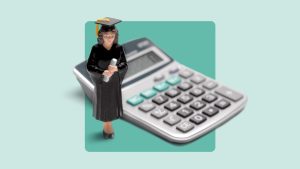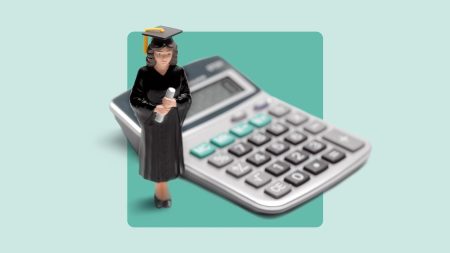Key takeaways
- You can refinance federal student loans, but doing so will cause you to lose certain benefits.
- Student loan refinancing can result in lower interest rates and monthly payments.
- Student loan refinancing is different from consolidation, which is also available for federal loans.
Student loan refinancing is one option for borrowers seeking relief from their existing student loan payments. It can result in lower monthly payments, better interest rates and a more manageable monthly payment. It’s not the best choice for everyone, however, especially borrowers with federal loans. It’s worth considering all options before moving forward with refinancing student loans.
Can you refinance federal student loans?
You can refinance your federal student loans, but it’s not always recommended. When you refinance your federal student loans, you take out a new loan with a private lender to pay off all or some of your existing student loan debt. The federal loans you refinance become private student loans, meaning you lose federal benefits like certain protections, access to income-driven repayment plans and potential loan forgiveness.
Refinancing your federal student loans can be a great way to reduce your monthly expenses, but there are trade-offs. Before refinancing your student debt, be sure to understand the process and the fine print you’ll want to keep an eye out for.
Bankrate insight
Keep in mind, consolidation is different from refinancing — while refinancing moves your debt to a private lender, consolidation streamlines your loans under a federal servicer.
Pros and cons of refinancing your federal student loans
Refinancing your federal student loans may come with some benefits, but at the cost of many others. You should never refinance your federal loans without first understanding what you’ll give up by doing so.
Pros of refinancing
- Lower interest rate. If you took out your federal student loans when interest rates were high, refinancing to a private student loan could save you thousands of dollars. This is especially true if you have good credit and qualify for the lowest advertised rates.
- Different repayment timeline. Federal student loans are automatically placed on a 10-year repayment timeline, unless you apply for another repayment plan. When refinancing, you can choose a shorter timeline to save on interest or a longer one to lower your monthly payments.
- Combine multiple loans. If you have loans from multiple lenders, refinancing can help you bundle up all of your accounts into one. This can make it easier to manage your debt.
Cons of refinancing
- No access to income-driven repayment. Income-driven repayment plans adjust your monthly payments to 10 to 20 percent of your discretionary income — a benefit private lenders lack.
- No loan forgiveness programs. Some federal borrowers qualify for Public Service Loan Forgiveness, which forgives your remaining loan balance after 10 years of qualifying payments. You’ll lose this benefit if you refinance, even if you’re close to meeting the requirement.
- Few defined deferment or forbearance programs. The federal government has established deferment and forbearance options for borrowers. While private lenders may offer hardship programs, they’re usually determined on a case-by-case basis.
- Forfeit potential relief options. During national crises, the government may provide relief options, as it did during the coronavirus pandemic. Private lenders may not.
When to refinance federal student loans
Although, in most cases, it doesn’t make sense to refinance federal student loans, there are times when it’s worth considering. Kristen Ahlenius, accredited financial counselor and director of education at Your Money Line, says to ask yourself the following before refinancing federal loans:
- Is your household income stable? “Suppose you experience a reduction or loss of income or even decide to return to school. In that case, there is greater guaranteed flexibility in the federal space than with a private lender,” Ahlenius says. “Of course, a private lender might offer some options, but these options aren’t standardized.”
- Are you certain loan forgiveness programs aren’t an option? Loan forgiveness is available for some borrowers who work for a nonprofit or government organization. “Be advised that forgiveness is only available for qualifying loans, which never includes private student loans,” Ahlenius says. “Before refinancing, be sure you can’t or won’t qualify for other forgiveness opportunities.”
How to refinance federal student loans in 2025
If you decide to refinance your federal student loans, you should find the best interest rate, lender and loan term to fit your financial situation. Here’s how to get started:
- Research lenders. Some lenders cater to specific borrowers, such as borrowers with low credit scores or borrowers refinancing medical school debt. Look for the lenders that fit best with your situation and compare interest rates, terms and fees. If you don’t know where to start, you can always use the help of a lending marketplace, such as LendKey, which allows you to compare offers from multiple lenders.
- Get prequalified. Once you’ve narrowed your search to two or three options, get prequalified with each to determine which will give you the best rate. Prequalification does a soft pull of your credit score to determine what interest rate you qualify for and is the best way to compare your options.
- Send in an application. After you’ve been prequalified with a lender, you can submit a full application. During this process, you’ll usually have to provide some form of ID, financial information and employment verification.
- Begin payments. Once the application is approved, your new lender will pay off your old loans directly. You’ll have to start making payments to your new lender immediately. Take time to learn how payments work, when they will be due and any other important details you’ll need to manage your loans with the new lender.
Federal student loan refinance vs. consolidation
Although people use the terms “refinancing” and “consolidation” interchangeably, they are different.
Refinancing is only done through private lenders, and it could change your loan details — your interest rate, repayment term and even lender. Because of this, you can often get a lower rate or a lower monthly payment.
Student loan consolidation is offered through the federal government. With this program, you can combine multiple federal student loans into one Direct Consolidation Loan and potentially change your repayment timeline. Consolidating loans may provide access to more repayment and loan forgiveness options.
Consolidation won’t necessarily save you money, because your interest rate will be the weighted average of all the loans you’re consolidating. If you choose a longer repayment term after consolidating, you may pay more in total interest over the life of the loan.
Other ways to pay off federal student loans
Refinancing to a new, lower-rate loan is a popular way for borrowers to pay off their student debt faster, but it isn’t the only way. Other options include:
- Extra payments. If you want to pay off your student loans quickly, pay more monthly. Start tracking your expenses and put any windfalls toward your debt. Paying off your loans faster will also help you pay less interest.
- Autopay discounts. All federal student loan servicers will give you a 0.25 percent discount each month when you sign up for automatic payments. If you apply the savings toward extra payments, that small discount can add up over time and help you eliminate your student debt a little faster.
- Employer student loan assistance. Some companies offer student loan assistance as an employee benefit. If you’re job hunting, look for positions that offer this benefit or see if you can negotiate student loan assistance as part of your new benefits package.
- State repayment assistance. Some places, like Maine, will pay a portion of your student loans if you move there. While you’ll have to meet specific eligibility requirements, you could knock out a significant portion of your debt.
- Student loan forgiveness. Depending on your situation, you might qualify for full or partial forgiveness of your federal student loan debt. You have to meet certain criteria to qualify for loan forgiveness, but you could save thousands of dollars on your loans.
Bottom line
Refinancing student loans is just one option for borrowers in repayment. Consider all options for repaying your federal student loans before moving forward with a refinance. If you choose that repayment path, make sure that the benefits, like a lower monthly payment or interest rate, outweigh such costs as losing income-driven repayment options and risking potential loan forgiveness.
Read the full article here









